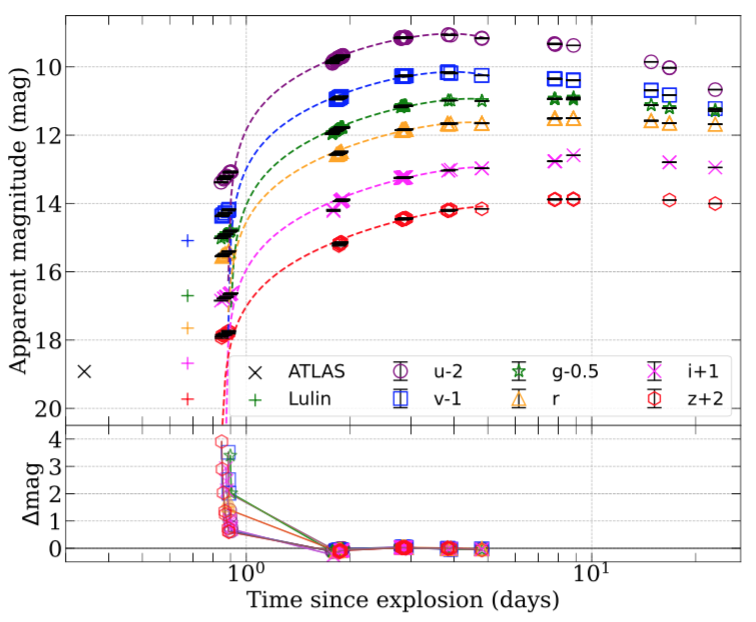云南大学梦飞巡天望远镜对超新星SN2024ggi开展多波段同时观测并取得重要发现
Multi-band Simultaneous Photometry of the Type II supernova SN 2024ggi with Mephisto
近日,云南大学中国西南天文研究所关于近邻星系超新星SN 2024ggi早期多波段光变演化的研究工作在国际天文学主流期刊美国《天体物理杂志快报》(The Astrophysical Journal Letters)正式接收发表。该项研究是完全基于云南大学1.6米多通道测光(梦飞)巡天望远镜数据完成的又一项重要工作,对理解II型超新星的爆发机制及星周环境有重要的科学意义。
超新星爆发是宇宙中最剧烈的爆发现象之一,峰值光度与整个星系的亮度相当。当大质量恒星(超过8-10倍太阳质量)星核的辐射压无法抵抗其自身的引力时,星核坍缩并产生超新星爆发,这类现象被称为核坍缩型超新星,其中爆发前保留大部分氢包层的核坍缩型超新星被称为II型超新星。II型超新星的光变和能谱特征能够揭示超新星爆发机制、星周介质环境,以及前身星性质等重要物理信息。
超新星SN 2024ggi最早由小行星撞击警报系统(ATLAS )于2024年4月11日发现。这颗超新星的距离为6.73 Mpc,是过去十年中距离地球最近的超新星之一。早期几个小时的光谱测量表明SN 2024ggi是一个具有显著耀发特征的II型超新星,其宿主星系为位于红移z=0.002435的NGC 3621。云南大学中国西南天文研究所梦飞团队在收到警报的第一时间利用梦飞巡天望远镜,开展了针对SN 2024ggi的早期高频次多波段(ugi和vrz)同时观测。梦飞巡天望远镜在该超新星爆发不到一天的时间内就对该超新星进行了快速后随,并在后续开展了长期监测,发现该超新星的uvg波段光变曲线早期快速上升(∼1.4 mag/day),并在爆发后第四天到达峰值 (显著快于一般的II型超新星),绝对星等为–17.75 mag。在峰值过后,较红波段的衰减率为∼0.01 mag/day。研究团队还发现该超新星在爆发两天后黑体温度显著升高,达到12500 K,并在此后逐渐降低,表明SN 2024ggi在前身星周围的星周介质中发生了激波突破。通过拟合半解析模型,研究团队揭示了该超新星抛射物的质量为1.2倍太阳质量,前身星为550倍太阳半径的红超巨星。该项研究表明近邻星系超新星的早期多波段探测对揭示超新星爆发机制和星周环境有重要的科学意义。
云南大学中国西南天文研究所梦飞巡天望远镜项目团队成员博士生陈鑫磊为该论文的第一作者,布拉杰什·库玛副研究员、尔欣中教授、刘晓为教授为该项研究的通讯作者。
梦飞巡天望远镜(Mephisto)是云南大学“双一流”建设重大科研平台,是国际上首台大视场、大口径、多通道高精度成像巡天望远镜。其独特优势在于可同时在3个波段拍摄天体图像,提供超高精度测光及颜色数据,实现对海量变源暂现源的快速可靠分类,录制宇宙天体运动和变化的彩色纪录片。2022年9月,梦飞巡天望远镜开始在丽江高美古观测站安装调试,同年10月23日实现小系统双通道四波段初光,2023年12月21日, 实现蓝黄红三通道同时出光。梦飞巡天望远镜于2024年4月11日开始对SN 2024ggi持续开展多波段同时观测。
梦飞巡天望远镜项目由云南大学中国西南天文研究所牵头研制并运行,得到了云南省政府和云南大学“双一流”经费支持。项目团队还得到了云南省兴滇英才支持计划“科技领军人才专项”(202005AB160002)、“创新团队”(202105AE160021) 和“顶尖团队”(202305AT350002)项目支持。预印本链接 https://arxiv.org/abs/2405.07964 。

图1. 梦飞巡天望远镜拍摄的星系NGC 3621及超新星SN 2024ggi的真彩色图像。
Figure 1. Real-color images of NGC 3621 galaxy and SN 2024ggi taken with Mephisto.

图2. 梦飞巡天望远镜测到的超新星SN 2024ggi多波段光变曲线。
Figure 2. Multi-band light curves of SN 2024ggi obtained with Mephisto.

Recently, a research work on the early-phase multi-band light curves of the nearby supernova SN 2024ggi by SWIFAR, Yunnan University has been accepted for publication in The Astrophysical Journal Letters. This research is another important work that is entirely based on the data from the Multi-channel Photometric Survey Telescope (Mephisto) of Yunnan University, which is of important scientific significance for understanding the explosion mechanism and the circumstellar environment of Type II supernovae.
Supernovae are one of the most violent explosive phenomena in the universe. The peak luminosity of a supernova is comparable to the luminosity of the entire host galaxy. When the radiation pressure from nuclear fusion in the core of a massive star (mass more than 8-10 Solar mass) cannot resist its own gravity, the star's core collapses, resulting in a supernova explosion. Such explosions are known as core-collapse supernovae (CCSNe), and Type II SNe are subclass of CCSNe where the progenitor star retains a significant amount the hydrogen envelope before the explosion. The light curve and spectral features of these Type II SNe can reveal important physical information of the supernova explosion mechanisms, the circumstellar environment, the progenitor properties, etc.
SN 2024ggi was first discovered by the Asteroid Terrestrial-Impact Last Alert System on April 11, 2024. This supernova, at a distance of 6.73 Mpc, is one of the closest SNe in the last decade. The early spectra taken within a few hours suggested that SN 2024ggi is a Type II SNwith prominent flash features, and it is in the host galaxy NGC 3621 at redshift z=0.002435. Mephisto team from SWIFAR, Yunnan University started monitoring this target within a few hours after the explosion and continued ~23 days. Team performed the early-phase good cadence (hour-to-day) simultaneous multi-band (ugi, vrz–bands) imaging of this nearby supernova with the Mephisto. The uvg-band light curves are found to display a rapid rise (∼1.4 mag/day) to the maximum in ∼4 days and absolute magnitude –17.75 mag, which is significantly faster than the light curves of other normal Type II SNe. The post-peak decay rate in redder bands is ∼0.01 mag/day. A significant rise (∼12500K) in black-body temperature (optical) was noticed within ∼2 days after the explosion, which successively decreased, indicating a shock breakout inside a dense circumstellar medium (CSM) surrounding the progenitor. Using semi-analytical modeling, the ejecta mass and the radius of the red supergiant progenitor were estimated as 1.2 Msun and ∼550 Rsun. This research indicates that the early-phase multi-band detection of supernovae in nearby galaxies has important scientific significance in revealing the explosion mechanism of supernovae and the circumstellar environment.
Xinlei Chen, a PhD candidate of the Mephisto team from SWIFAR, Yunnan University, is the first author of the research paper. Associate researcher Brajesh Kumar, Prof. Xinzhong Er, and Prof. Xiaowei Liu are the corresponding authors of this research.
Mephisto is a 1.6-m wide-field multi-channel telescope, the first of its type in the world, capable of imaging the same field of view in three optical bands simultaneously. It yields real-time, high-quality colors of unprecedented accuracy of billions of objects, enables fast and robust classification of variables and transients, and for the first time, delivers a panoramic and panchromatic documentary of our dynamic universe. The on-site telescope assemblage and commissioning began in September 2022, and the first light in dual channels of four bands for a pilot system covering one quarter of the full field of view was achieved on October 23, 2022. Mephisto realized the first light in blue, yellow, and red channels simultaneously on December 21, 2023. Mephisto performed multi-band simultaneous observation for SN 2024ggi from April 11, 2024.
Mephisto is developed at and operated by SWIFAR-YNU, funded by the “Yunnan University Development Plan for World-Class University” and “Yunnan University Development Plan for World-Class Astronomy Discipline”. The project team also receives support from the “Science & Technology Champion Project” (202005AB160002) and from two “Team Projects” -- the “Innovation Team” (202105AE160021) and the “Top Team” (202305AT350002), all funded by the “Yunnan Revitalization Talent Support Program”. The arXiv link of this research paper is https://arxiv.org/abs/2405.07964 .
